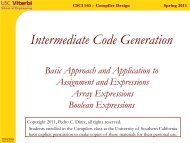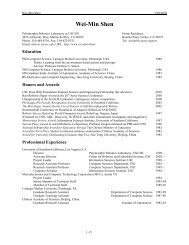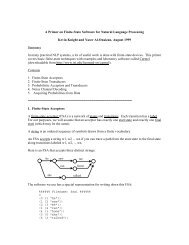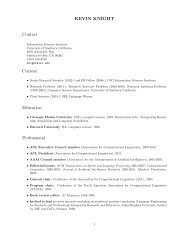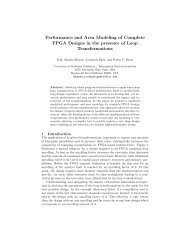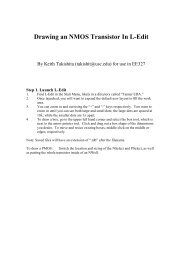Induction of Word and Phrase Alignments for Automatic Document ...
Induction of Word and Phrase Alignments for Automatic Document ...
Induction of Word and Phrase Alignments for Automatic Document ...
Create successful ePaper yourself
Turn your PDF publications into a flip-book with our unique Google optimized e-Paper software.
Computational Linguistics Volume 1, Number 1<br />
Table 2<br />
Jump probability decomposition; the source state is either the designated start state, the<br />
designated end state, a document phrase position spanning from i to i ′ (denoted ri,i ′) <strong>for</strong> a null<br />
state corresponding to position i (denoted r∅,i).<br />
source target probability<br />
〈start〉 ri,i ′ jump rel (i)<br />
ri,i ′ rj,j ′ jump rel (j − i′ )<br />
ri,j ′ 〈end〉 jump rel (m + 1 − i′ )<br />
〈start〉 r∅,i jumprel (∅)jumprel (i)<br />
r∅,i rj,j ′ jumprel (j − i)<br />
r∅,i r∅,j jumprel (∅)jumprel (j − i)<br />
r∅,i 〈end〉 jumprel (m + 1 − i)<br />
ri,i ′ r∅,j jumprel (∅)jumprel (j − i ′ )<br />
requirement involving parameter re-estimation, which essentially says that the expectations<br />
calculated during the <strong>for</strong>ward-backward algorithm must be sufficient statistics<br />
<strong>for</strong> the parameters <strong>of</strong> the jump <strong>and</strong> rewrite models. This constraint simply requires that<br />
whatever in<strong>for</strong>mation we need to re-estimate their parameters is available to us from<br />
the <strong>for</strong>ward-backward algorithm.<br />
4.1 Parameterizing the jump model<br />
Recall that the responsibility <strong>of</strong> the jump model is to compute probabilities <strong>of</strong> the <strong>for</strong>m<br />
jump(j ′ | j), where j ′ is a new position <strong>and</strong> j is an old position. We have explored<br />
several possible parameterizations <strong>of</strong> the jump table. The first simply computes a table<br />
<strong>of</strong> likely jump distances (i.e., jump <strong>for</strong>ward 1, jump backward 3, etc.). The second<br />
models this distribution as a Gaussian (though, based on Figure 2 this is perhaps not<br />
the best model). Both <strong>of</strong> these models have been explored in the machine translation<br />
community. Our third parameterization employs a novel syntax-aware jump model that<br />
attempts to take advantage <strong>of</strong> local syntactic in<strong>for</strong>mation in computing jumps.<br />
4.1.1 The relative jump model. In the relative jump model, we keep a table <strong>of</strong> counts<br />
<strong>for</strong> each possible jump distance, <strong>and</strong> compute jump(j ′ | j) = jump rel (j ′ − j). Each possible<br />
jump type <strong>and</strong> its associated probability is shown in Table 2. By these calculations,<br />
regardless <strong>of</strong> document phrase lengths, transitioning <strong>for</strong>ward between two consecutive<br />
segments will result in jump rel (1). When transitioning from the start state p to state ri,i ′,<br />
the value we use a jump length <strong>of</strong> i. Thus, if we begin at the first word in the document,<br />
we incur a transition probability <strong>of</strong> j1. There are no transitions into p. We additionally<br />
remember a specific transition jump rel (∅) <strong>for</strong> the probability <strong>of</strong> transitioning to a<br />
null state. It is straight<strong>for</strong>ward to estimate these parameters based on the estimations<br />
from the <strong>for</strong>ward-backward algorithm. In particular, jump rel (i) is simply the relative<br />
frequency <strong>of</strong> length i jumps <strong>and</strong> jump rel (∅) is simply the count <strong>of</strong> jumps that end in a<br />
null state to the total number <strong>of</strong> jumps. The null state “remembers” the position we<br />
ended in be<strong>for</strong>e we jumped there <strong>and</strong> so to jump out <strong>of</strong> a null state, we make a jump<br />
based on this previous position. 5<br />
5 In order <strong>for</strong> the null state to remember where we were, we actually introduce one null state <strong>for</strong> each<br />
document position, <strong>and</strong> require that from a document phrase¦ i:j, we can only jump to null state ∅j.<br />
12





